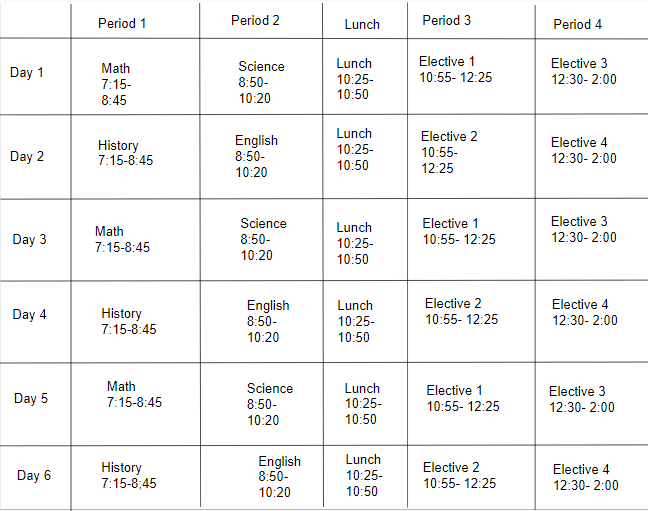How will Block Scheduling Affect Pennridge High School?
Example of a Block Schedule
As time goes on, schools continue to implement new methods of instruction. This new method that is being discussed is block scheduling. Block scheduling has been around since the 1970s with “fluid block scheduling” being introduced. This system became popular and was deemed successful, granting students and teachers many benefits. Currently, at Pennridge, the school board is planning on implementing this block scheduling in two years’ time. This plan has been responded to with mixed reviews from the students and the teachers within Pennridge High School.
Before getting into the positives and negatives of this system and how it will affect Pennridge, it is important to first define what it means to have a block schedule. Our traditional schedule at Pennridge has around seven classes with each being about 50 minutes, and at 180 days of each class, it results in there being 9,000 minutes of total class time. As for block scheduling, there are three different types of block scheduling. The first of these types of block scheduling is accelerated block schedule. This type of block scheduling has four classes daily for four months during the first semester. Each class would be 90 minutes per day for 90 school days. The next type of block schedule is the A/B block schedule. This schedule maintains the extended class period with the course divided into two primary divisions. The divisions are “A block” which are periods 1-4 and “B block” which are periods 5-8. Each block will have its four classes three times a week, and their classes will swap when the week is over. The final type of block schedule is the Modified Block Schedule hybrid of A/B and traditional. You would attend certain classes every day for around 45 minutes with some periods alternating between typically longer days.
Pennridge is planning on likely using an A/B block schedule with each class being 90 minutes long. This has many pros and cons to the overall well-being of the school. The first of these positives is that it promotes cooperative learning with teachers being able to work in smaller group learning and using student collaboration more. It provides more quality time with teachers getting closer to their students and learning about their individual needs. Alongside that, there are more with fewer classes a day equating to more focus per subject. The added benefit is less daily homework and longer planning periods. Dr. Kathy Scheid, the assistant superintendent for Pennridge who is in charge of the block scheduling implementation, states that the most important part of block scheduling is that it “would give more time to learn more deeply in the content area.” Even though that is a great reason as to why block scheduling should be implemented, there are also negatives to having block scheduling. The first is a loss of continuity with a day between each subject, so it is revisited later. There is also a greater loss from an absence with a student practically missing two lessons rather than the one they usually do. And the most important negative to block scheduling is that it is too fast. Since there are fewer days for each subject, the curriculum is sped up. If a student can’t keep up, they can’t sufficiently learn.
With all of these negatives and positives, Pennridge has mixed reviews. Along with those problems is how the school plans to implement the new system. Many teachers are unsure what will happen because it is vague and minimal information has been provided. There are also other factors like some teachers moving from middle to high school. That question leaves teachers like Leanna Goodrich who is a German teacher for the high school and middle school confused about what the future of this system will be as she states, “It’s not been made clear what a full teaching schedule is for a person who goes back and forth between buildings.” Many teachers have shared a similar sentiment with some worrying about how they are going to implement and how smooth the transition will be. One worried about the transition is Michael Garrison, a teacher within Pennridge whose main worry is that they won’t be “given enough time for transition.” Many questions are still being formulated and answered. It can be stated that this system is going to need more time to create a block schedule the school board can proud of.
Sources:
https://www.uopeople.edu/blog/what-is-block-scheduling/
https://educationadvanced.com/resources/blog/the-block-schedule-system-7-pros-and-3-cons/
Sullivan Heying, Grade 12. Interests/hobbies include piano, tennis, basketball, football, NHS, and chess. Sullivan wants to go to Notre Dame and then go...










